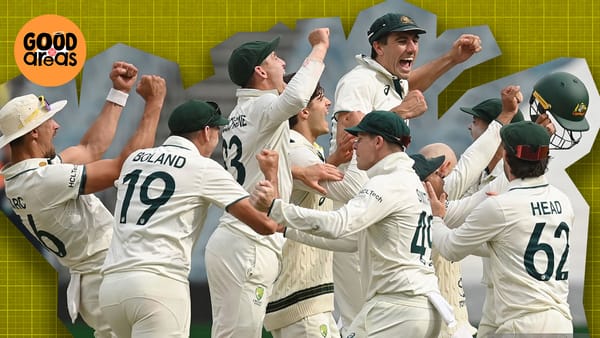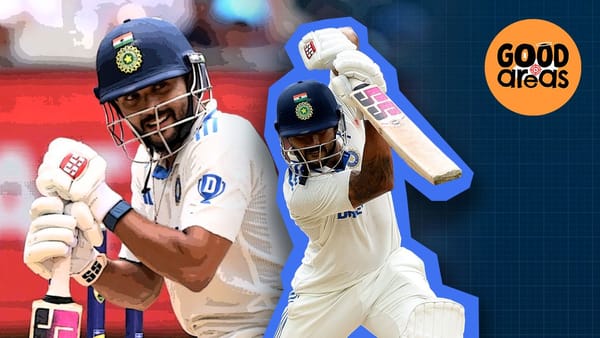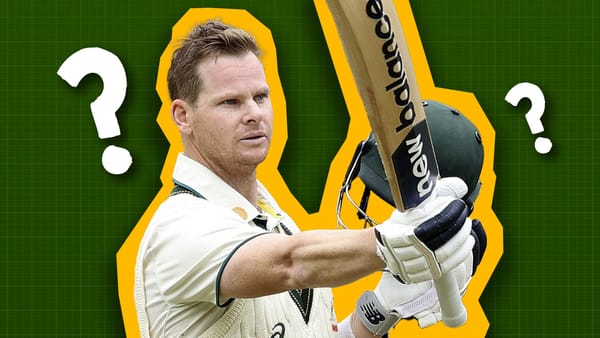Overarm bowling
It took cricket 70 years to allow overarm bowling
This is the transcript for Episode 4, Season 1 of Double Century on overarm bowling.
Ol' Everlastin. That is what they called Tom Walker. He was known as that because of how long he batted. But it only took him one ball to help change cricket forever.

Welcome to Double Century. This week is about the biggest law change in cricket, and without it, this podcast would not exist. Your signed Glen Chapple trading card would be worthless and Gautam Gambhir would be even more overlooked.
Had cricket stayed as an underarm sport, it wouldn't be this game. It would be like a slightly harder version of croquet, and it would've been something you did in private gardens on Sunday afternoons. Without overarm bowling, cricket would be like snuff, something Tatler magazine covers and the really posh girl from your college tries to explain to you halfway through your first shrooms. Instead, it's a massive worldwide business with close to a billion fans. And that all started with a professional being shadowbanned, a woman with large dresses and a man storming off Lord's on a horse. Sort of.

David Frith has long debated that the birth of cricket wasn't Hambledon, and while he just picks another old club. I'd argue the actual birth was in the streets. But Hambledon is known as the cradle of cricket, but it is truly the cradle of gentlemen's cricket. Kids were playing cricket all over the UK well before anyone had heard of Hambledon. But Hambledon is where cricket laws were written and the game starts being narrated. The kids didn't write books about how they started cricket, Hambledon did. It was formed sometime around 1760. It’s in rural Hampshire. Although it wasn't in London, the noblemen and country gentry flocked to it. They charged spectators to come in, and everyone had a bet. Lord's didn't exist at this point.

Tom Walker was a pro at Hambledon, his nickname was 'ol everlasting'. He was a batsman who would bat as the first man in, and often last man out. They say he once faced 107 balls off one bowler and scored a single from it. John Nyren wrote in 'The young cricketers' tutor', that Walker was "a hard, ungainly scrag-of-mutton frame; weird, apple-John face; long spider legs, as thick at the ankles than at the hips, the driest and most rigid limbed chap; his skin was like the rind of an old oak, and as sapless. He moved like the rude machinery of a steam engine in the infancy of construction and when he ran, every member seemed ready to fly to the four winds".
Walker did something even more amazing than move like rude machinery or score 1 from 107 balls, he attempted to introduce a new form of bowling, or throwing style, into proper cricket in 1788.
There is a school of belief that outside the Earl of Winchelsea's entourage and Hambledon's other elite, in the streets and parks, kids and adults had been doing it for years. But their games were never reported on unless someone died, used a dog as a player, or it ended in a brawl.
At Hambledon, such disgusting bowling would never be allowed, and instantly Walker was called for a no ball and told by the 'council of the Hambledon Club' that they considered it foul play. Batsmen were on this committee, batsmen of nobility and pedigree. Walker's rudimentary round arm was fast and scary, and no one wanted to face it. So they told him not too. And although Walker played somewhere that could be reported on, his lowly status as a professional meant it was easy to force him into giving up this ball. By bowling that way, he was putting his earnings in danger, so he just never did it again.
We know about all this because of a book. I have a copy, not much of a copy, I carried it around the World Cup one time - never actually read it - and it got more ruined than it already was. Many of cricket's early stories are from this book. It's an incredible piece of cricket history. Many of the stories are probably not first hand, or plagiarized from other sources. Not to mention it was written 40 years after the event. But this book gives us so much information about the early game.
For instance, this is on how the bat size law came in "Several years since (I do not recollect the precise date) a player, named White, of Ryegate (sic), brought a bat to a match, which being the width of the stumps, effectually defended his wicket from the bowler: and, in consequence, a law was passed limiting the future width of the bat to 4¼ inches. Another law was decreed that the ball should not weigh less than 5½ oz, or more than 5¾ oz." The book itself is little more than 100 pages, but a bit like the Ashes urn, size isn't everything.
SE1EP4 - overarm
— Jarrod Kimber (@ajarrodkimber) 8:33 PM ∙ Nov 20, 2020
This was a 70-year battle where good triumphed over underarm.
Tom Walker kept playing as a batsman and a lob bowler. Literally lobbing the ball up high, people were still doing it in first class cricket up until the First World War. Almost 20 years after the round arm incident, he played in a match where John Willes Esquire was playing. Willes had a sister named Christiana who loved playing cricket. She would help her brother.
According to an article from her son, almost a 100 years later in 1907, "It was my mother's skill in throwing the ball to him [John Willes] for practice in the barn at Tonford … He then trained a dog to fetch the ball, and there was a saying that Willes, his sister, and his dog could beat any eleven in England".

So if you have ever heard the story that a woman invented overarm bowling because of big dresses, think of those toilet-roll holders, big hooped creations that jut out, well this is where it comes from. The weird thing is her son never actually mentioned the dresses, that was added later, and the story became part of cricket's folklore. The dress story is not true, John Major's book discredits it, and I spoke to a fashion historian for my book and English women didn't wear hooped Crinoline dresses in that time. That doesn't mean Christiana didn't hurl the ball back in a way that inspired her brother, but the only recording of this is from her son, almost a 100 years later, and he wasn't there.
The Willes weren't a normal family, they were elites, Illuminati, one-percenters, that kind of deal. John Willes played in both of the first two Gentlemen Vs Players games. He was OG - Original Gentleman). But Willes had bowled this way in many smaller games, bringing in this roundarm action over a 15-year period. Cricket never completely outlawed it, even if he wasn't always invited to play because of it. In 1922 he played for Kent against the MCC, he bowled one of his round arm balls, was called for a no ball for throwing - the first to be ever called for chucking - and then left the field, got on a horse, rode into the sunset and never played cricket again. How much of that is true, I don't know, but it was his final first class game.

The bowling of John Willes, possibly Christiana's as well, and even that of Tom Walker was quite different from the norm. Underarm bowling was kind of rubbish. Okay to your three-year-old nephew, but not really a demanding athletic endeavour that would captivate millions of people like Wes Hall in mid-flight.
But if you are imagining some Richard Hadlee moustached chap with grace coming in, that wasn't the case. The early roundarm bowlers came around the wicket and sort of hurled the ball like a drunk Lasith Malinga.
There was a powerful group of people that didn't want roundarm bowling, and later on would fight overarm bowling as well. William Ward was the man who bought Lord's off Thomas Lord to stop him from putting a property development on it. The consensus of Ward and other haters was that it was ruining the game. It would ruin batsmen. It could cause injury. It was throwing. It was horrid. It was "repugnant".
It certainly was changing the game, look at a picture of the original cricket bats, they are really hockey sticks, because that is what you need for hitting a ball along the ground, as the ball was lifted off the surface bats evolved with it. But many players used huge heavy bats, and played to an old age, roundarm bowling would make it a game for younger more athletic folk. During this period, cricket pads weren't that common. Nicholas Felix and Fuller Pilch wore them, and there were bad injuries in 1836 and 1841, with batsmen having their leg broken from facing round arm balls. There was even a story that one bowler had bowled so quickly that his wicket keeper had missed it, and then the ball had gone through the jacket of his long stop and killed a dog. The message was clear, roundarm bowling broke legs and killed dogs.
Cricket was splitting into two factions at this time. The Sporting Magazine ran pieces by Mr G.T Knight and Mr Denison, stating the cases of both sides of the argument. Mr Knight was a fan and practitioner of overarm said a truth that still haunts cricket to this day, "It is universally admitted that batting dominates bowling to an extent detrimental to the game".
Mr Dennison was against it, his main three reasons were involving it being throwing, that it could be dangerous, and this, "The new style is fatal to all scientific play, putting a premium on chance hits, and placing scientific defence at a discount." Others thought roundarm bowling would result in "rough, coarse, horseplay".

Mr G.T Knight was actually George Knight. George Knight was born to Edward Knight. Edward Knight was born Edward Austen, Jane Austen's brother. Jane Austen's nephew George was a roundarm bowler. He was also the proponent of the experimental cricket matches to win over the MCC and people like William Ward to the benefits of round arm bowling.
The games were between Sussex and All-England. Sussex had two bowlers who were following the current cricket law of raising your arm as high as your elbow. They beat England easily in the first two matches. For the third match, some players from All-England wrote a letter "We, the undersigned, do agree that we will not play the third match between All-England and Sussex, which is intended to be played at Brighton in July or August unless the Sussex bowlers bowl fair – this is, abstain from throwing". The underarm and undermanned England side won that third game. It was entirely possible that it was fixed so they could maintain some face.
In 1835, the MCC, now fully in charge of the laws of cricket, changed the law to "The ball must be bowled, and if it be thrown or jerked, or if the hand be above the shoulder in the delivery, the umpire must call no ball". It wouldn't slow down evolution, bowlers kept raising their arms higher and higher, and this also changed how batsmen played. Still cricket fought evolution. Overarm bowling, as it is practised today, was not legalised until 1864, only 13 years before the first-ever Test.
Gideon Haigh disagrees with me over the fact this is the most important change to cricket, he thinks it was inevitable, a natural evolution. But there were powerful people who were fighting against it, and this took 70 years for cricket to properly change. Many things could have happened to cricket in that time. There could have been a Rugby type split, another sport could have taken a stranglehold, or cricket could have continued as this underarm game and never got aroused the interest of anyone outside England. It is thanks to overarm bowling, and those who fought for it, that cricket became what we love today.
What these people did was make the game of cricket what we love. Because underarm bowling is largely bullshit, even more so than offspin, and back then, cricket was only slightly more interesting than croquet. If it stayed as underarm only, it would have ended as entirely a sport of the English elite. The best athletes would have gone to other sports. It would barely be a sport at all, more an eccentric novelty, a garden game for weddings at country estates. Instead, because of people like Tom, Christiana, Edward and John, it's everlastin.
Double Century is written and narrated by me, Jarrod Kimber. It’s produced by Nick McCorriston. And my fact-checkers were Bertie Moores and Abhishek Mukherjee.
This episode was made possible by our supporters on Patreon.




